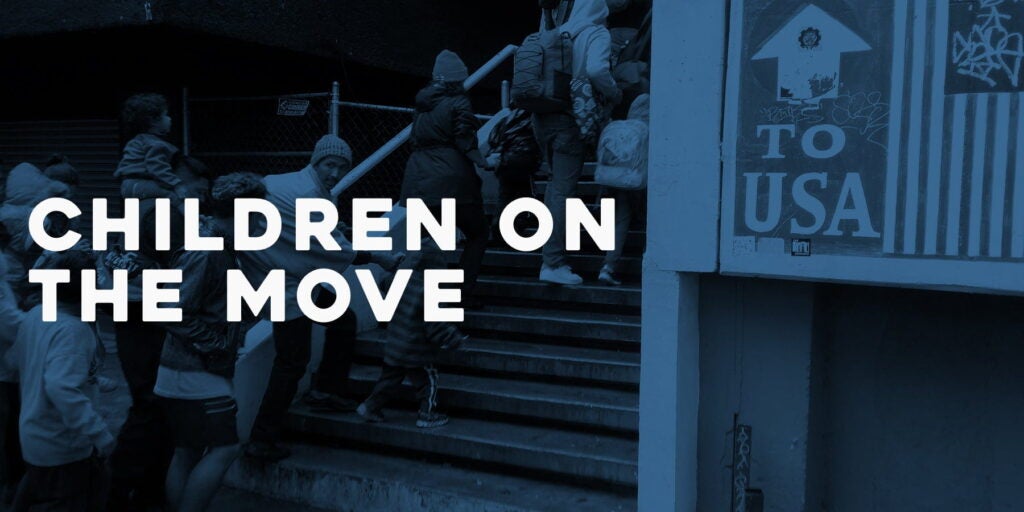Children on the move (CoM) refers to a broad category of children that move within or between countries for a variety of reasons. The movement may or may not be voluntary. Children on the move may be seeking employment and educational opportunities, escaping war and political violence, seeking reunification with family, or being forcibly trafficked. They travel alone or with family members, and may be classified as refugees, internally displaced persons, unaccompanied children/minors, and voluntary migrants.
Program Goals
Develop Recommendations for more Coherent and Effective Policies
Our Children on the Move program sought to influence the development of legal, social, cultural, and educational policies directly affecting children on the move. Insofar as the policies enforce human rights and have implications for social justice, integration, and child protection, the goal is for them to also benefit those whose lives intersect with migrant children in origin, transit, and destination states.
- See the April 2017 report on exploitation of refugee minors in Greece, Emergency Within An Emergency;
- See the report Children on the Move: An Urgent Human Rights and Child Protection Priority (November 2016) (download in its entirety here, the table of contents only, or individual sections later on this page).
- See the newly developed (June 2016) tool, “Recommended principles to guide actions concerning children on the move and other children affected by migration.”
Promote A Rights Respecting Approach
The dominant approach to conflict prevention, migration and child protection/welfare — both policy and practice — in Europe, Africa, and Asia is siloed and incomplete. A second goal of the project was to replace this approach with rights respecting measures for CoM across national borders and within countries.
Promote Enforcement
We also aimed to promote systemic approaches to enforce the rights and wellbeing of children and young people affected by migration who are at risk of violence, exploitation, marginalization, and deprivation.
Our Approach
We undertook two comprehensive reviews. One, a framing review, considered current legal and policy approaches to CoM. The other, a learning review, dealt with sexual abuse and exploitation of CoM. The reviews were informed and supplemented by seven cases that illustrated the risks faced by CoM in different contexts and the need for more comprehensive policies and programs to protect this population.
Children on the Move Framing Review
The framing review outlined international, regional and national legislation, as well as guidelines and procedures covering children who move whether for family, survival, exploitation, or mixed reasons. It made recommendations for a more comprehensive approach that recognized and implemented children’s right to basic services regardless of immigration or documentation status. It also recommended that children on the move not be discriminated against or criminalized.
Children on the Move Learning Review
The CoM learning review explored knowledge about sexual abuse and exploitation of children on the move. It considered risk factors prior to the start of migration, in the child’s home or previous environment, during the various phases of the migration journey, and then during the multiple stages of arrival, resettlement, and integration or assimilation. The review documented the impact of a range of elements on the probability of exposure to sexual exploitation and abuse. Risk amplifiers included: (a) poverty and other inequalities, (b) gender-based discrimination and violence, (c) armed conflicts and political violence, (d) insufficient educational opportunities, (e) disruption of family systems, and (f) demographic shifts to an increasingly youth-dominated population.
Cases
Seven cases demonstrated context-based challenges faced by children on the move, as well as strengths and gaps in policies and programming:
- Examples of Good Practices: Germany (education), Sweden (protection of unaccompanied minors), and the United Kingdom (age assessment);
- In Transit: On and Through Lesbos, Greece;
- En Route Through Europe: On the Western Balkan Route via Serbia;
- Exclusionary Practices: The Difficulty of Entering the United States and Australia;
- The Impact of Persistent Exclusion: Rohingya Leaving Myanmar;
- Internal Migration: From Bihar to Rajasthan, India; and
- Living Rough: On the Street in Senegal.


